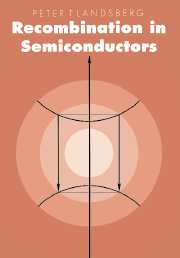Book contents
- Frontmatter
- Contents
- List of main symbols
- Note on units
- Introduction
- 1 Semiconductor statistics
- 2 Recombination statistics
- 3 Auger effects and impact ionization (mainly for bands)
- 4 Radiative recombination (mainly for bands)
- 5 Defects
- 6 Multiphonon recombination
- 7 Recombination in low-dimensional semiconductor structures
- Appendix A The delta function (section 3.2)
- Appendix B Useful identities arising from the periodic boundary condition (section 3.4)
- Appendix C Fourier expansions (section 3.4)
- Appendix D The effective mass sum rule and the dynamics of Bloch electrons (section 3.6)
- Appendix E Diagonalization and Jacobian for the threshold energy and impact ionization calculation (section 3.5.7)
- Appendix F The saddle-point method, and the method of stationary phase (section 6.3)
- Appendix G Evaluation of the integral (6.6.12) (section 6.6)
- References
- Index of names
- Index of topics, concepts and materials
- Frontmatter
- Contents
- List of main symbols
- Note on units
- Introduction
- 1 Semiconductor statistics
- 2 Recombination statistics
- 3 Auger effects and impact ionization (mainly for bands)
- 4 Radiative recombination (mainly for bands)
- 5 Defects
- 6 Multiphonon recombination
- 7 Recombination in low-dimensional semiconductor structures
- Appendix A The delta function (section 3.2)
- Appendix B Useful identities arising from the periodic boundary condition (section 3.4)
- Appendix C Fourier expansions (section 3.4)
- Appendix D The effective mass sum rule and the dynamics of Bloch electrons (section 3.6)
- Appendix E Diagonalization and Jacobian for the threshold energy and impact ionization calculation (section 3.5.7)
- Appendix F The saddle-point method, and the method of stationary phase (section 6.3)
- Appendix G Evaluation of the integral (6.6.12) (section 6.6)
- References
- Index of names
- Index of topics, concepts and materials
Summary
Introduction
The word ‘flaw’ was introduced by Shockley and Last [5.1.1] ‘for the purpose of distinguishing between imperfections with multiple possibilities for charge condition and ordinary donors and acceptors’ following the early work on the statistics of these centers described in [5.1.2].
In fact it is a convenient term which encompasses both chemical and physical defects and it is sometimes used in this generalized sense [5.1.3]. We shall here use the term defect and use an amended form of Blakemore's classification scheme (Fig. 5.1.1). This is not done to give a systematic discussion of these defect classes (this requires a major book), but to indicate the variety of possibilities. (An As atom sitting on a Ga site (AsGa) in GaAs is a typical anti-site defect.) There is a further classification [5.1.4] which depends on the value of
Δz = valency of the impurity – valency of the host
On this basis what is often called an isoelectronic defect, defined by Δz = 0, is more logically named isovalent, since the total number of electrons on the atom involved to which the term ‘isoelectronic’ refers is often of minor relevance.
- Type
- Chapter
- Information
- Recombination in Semiconductors , pp. 369 - 446Publisher: Cambridge University PressPrint publication year: 1992



